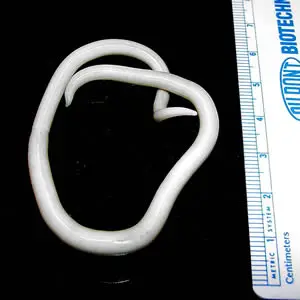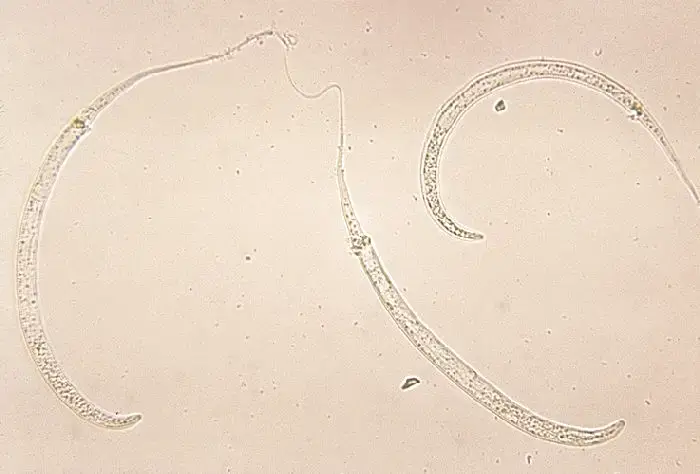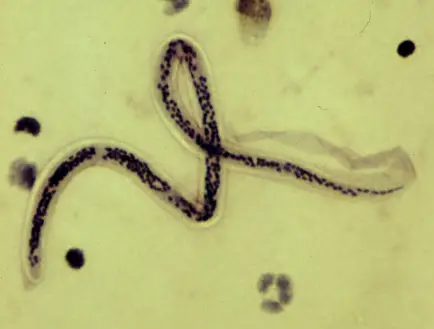Phylum Nemathelminthes
- Phylum Nemathelminthes, commonly known as Nematoda or roundworms, represents a diverse group of unsegmented, triploblastic, and pseudocoelomic worms. Their name is derived from the Greek words “nematos,” meaning thread, and “helminthes,” meaning worm, which accurately describes their thread-like appearance. While some zoologists consider Aschelminthes as a superphylum, with Nematoda being one of its various groups, others regard Aschelminthes as a distinct phylum and Nematoda as its largest group.
- Nematodes play significant roles in various ecosystems, particularly in soil ecosystems. Many species of nematodes found in the soil are involved in nutrient recycling as they feed on bacteria, fungi, and other nematodes. They also contribute to biological control by attacking insects and controlling pests. However, some nematodes can be detrimental to plants as they feed on their roots, leading to reduced nutrient uptake and decreased stress tolerance.
- In addition to their ecological importance, nematodes are known to cause diseases in humans. A single spadeful of soil can contain numerous nematodes capable of transmitting diseases such as Ascariasis, Trichuriasis, Hookworm, Enterobiasis, Filariasis, and Angiostrongyliasis. These parasitic nematodes can have significant impacts on human health.
- The organisms belonging to the phylum Nematoda are commonly referred to as “roundworms.” To date, around 28,000 species of nematodes have been identified, with approximately 15,000 of them being parasitic in nature. These unsegmented vermiform animals possess a body covered with a transparent cuticle composed of scleroprotein. Their body shape is round in cross-section, and they exhibit a tube-within-a-tube body plan, indicating an organ-system grade of body organization.
- Nematodes have a pseudocoelom, which is a false coelom derived from the embryonic blastocoel. Their body walls consist of longitudinal muscles, while the epidermis is syncytial and typically lacks cilia. They lack a distinct head region, but their digestive tract is complete and usually surrounded by lips bearing sensory organs. The alimentary canal of nematodes has both a mouth and an anus.
- Respiratory and circulatory systems are absent in nematodes. Instead, their excretory system consists of one or two renette cells or protonephridia. The nervous system comprises a circumpharyngeal nerve ring and six longitudinal nerve cords. Nematodes possess sensory papillae, such as amphids located in the mouth region and phasmids found near the anus. All nematodes are dioecious, meaning they have separate sexes and exhibit sexual dimorphism. This characteristic makes them the first phylum to exhibit unisexual reproduction.
- Nematodes produce eggs with a chitinous shell, and their cleavage during embryonic development is determinate and spiral. They have different larval forms, including rhabditiform, filariform, and microfilariae larvae.
- In terms of classification, Nemathelminthes encompasses five classes: Rotifera, Gastrotricha, Kinorhyncha, Nematomorpha, and Nematoda. Among these, Nematoda is the most prominent class, comprising a vast array of roundworm species.
- In summary, Phylum Nemathelminthes, or Nematoda, represents a diverse group of unsegmented, cylindrical worms commonly known as roundworms. They exhibit unique anatomical and physiological characteristics and play significant ecological roles in soil ecosystems. While some nematodes are beneficial, others can be harmful to plants and cause diseases in humans. Their classification within the animal kingdom highlights their importance and widespread distribution throughout the world.
General Characteristics of Nemathelminthes
Phylum Nemathelminthes, also known as Nematoda or roundworms, exhibit several general characteristics that define their biology and classification. Here are some key characteristics of nematodes:
- Habitat: Nematodes are found in a wide range of environments, including freshwater, marine, and terrestrial habitats. They are ubiquitous and can be found in various ecosystems worldwide.
- Body Structure: Nematodes have an elongated, cylindrical body shape. They are unsegmented and vermiform, tapering at both ends. The size of nematodes can vary significantly among different species.
- Cuticle: The body of nematodes is covered by a resistant, inelastic, and thick cuticle. This cuticle protects the worms and is periodically molted during growth.
- Body Wall: The body wall of nematodes consists of a syncytial epidermis invaginated into four longitudinal cords. Longitudinal muscles are present between these cords, forming a thick muscle layer.
- Body Cavity: Nematodes have a pseudocoelom, which is a body cavity not lined by a mesodermal layer. The pseudocoelom contains pseudocoelomic fluid rich in proteins and organic metabolites.
- Movement: Nematodes exhibit undulating movement in the dorso-ventral plane. This movement is produced by the alternate contraction and expansion of the longitudinal muscles.
- Digestive System: Nematodes have a straight and complete digestive tract with two openings, a mouth and an anus. The mouth is typically located in the anterior region and is surrounded by lips bearing sensory organs.
- Respiratory and Circulatory Systems: Nematodes lack specialized respiratory and circulatory organs. Respiration occurs through the general body surface, and it is aerobic in free-living forms and anaerobic in parasitic forms.
- Excretory System: The excretory system of nematodes consists of a few renette cells or a canal system. They do not possess flame cells, which are typically found in other organisms.
- Nervous System: Nematodes have a relatively simple nervous system. It includes a circumpharyngeal nerve ring surrounding the pharynx and four peripheral longitudinal nerves. Sense organs, such as amphids located in the mouth region and phasmids near the anus, are poorly developed.
- Reproduction: Nematodes are dioecious, meaning they have separate sexes. They exhibit sexual dimorphism, with distinct differences between males and females. Sexual reproduction is the common form of reproduction in nematodes, and fertilization is internal.
- Development: Nematodes produce fertilized eggs that are often surrounded by a tough capsule. The cleavage during embryonic development is determinate, and different species may have various larval stages. The development of nematode embryos can occur with or without intermediate hosts.
Structure of Nemathelminthes
Nemathelminthes, also known as roundworms or nematodes, exhibit a unique structure that distinguishes them within the animal kingdom. Here are the key structural features of Nemathelminthes:
- Unsegmented Body: Nemathelminthes have an unsegmented body, meaning they lack distinct body segments.
- Pseudocoelomate Body Cavity: The body cavity of nematodes is filled with muscles and is called a pseudocoelom. Unlike true coeloms, the pseudocoelom is not lined by a mesodermal layer.
- Lack of External Differentiation: Externally, nematodes show little differentiation between the anterior and posterior regions of their body. They lack a distinct head but have a mouth in the anterior region.
- Tough Cuticle: The body of nematodes is covered with a tough and resistant cuticle. This cuticle is periodically cast off or molted during the growth phase. It serves as protection against the action of digestive juices.
- Complete Digestive System: Nematodes possess a complete and straight digestive system with both a mouth and an anus. The mouth is located at the anterior end and is surrounded by lips bearing sensory organs.
- Respiratory and Circulatory Organs: Nematodes do not have specialized respiratory or circulatory organs. Instead, respiration occurs through the general body surface. Free-living forms respire aerobically, while parasitic forms respire anaerobically.
- Excretory System: The excretory system of nematodes consists of intracellular canals or lateral excretory ducts. These structures play a role in excretion and osmoregulation.
- Nervous System: The nervous system of nematodes is not highly developed. It consists of a circumpharyngeal nerve ring surrounding the pharynx and longitudinal nerve cords running along the body.
- Sense Organs: Nematodes have poorly developed sense organs in the form of papillae. These include amphids, which are sensory organs located in the mouth region, and phasmids, sensory organs near the anus.
- Unisexual Reproduction: Nematodes exhibit sexual dimorphism and have separate sexes. They are unisexual organisms, meaning individuals are either male or female.
- Internal Fertilization: Fertilization in nematodes is internal, and it can occur through cross-fertilization or self-fertilization, depending on the species.
- Development: The development of nematodes can be direct or indirect. Larval forms in nematodes include Rhabditiform, Filariform, and Microfilaria larvae.
- Lateral Lines and Pores: The body surface of nematodes may have various lateral lines and pores, which are important for sensory perception and communication.
Classification of Nemathelminthes
The phylum Nemathelminthes, also known as Aschelminthes, encompasses a diverse group of organisms, including nematodes or roundworms. The classification of nematodes is based on various characteristics, including the presence or absence of sensory organs called phasmids. Here is a classification of nematodes along with examples:
CLASS I: Aphasmidia/Adenophoria
- Phasmids are absent in these nematodes.
- They lack excretory canals.
- Amphids (another type of sensory organ) are located behind the lips.
- Most of them are free-living, although some are parasitic.
- Free-living species include many marine inhabitants.
Order 1: Enoploidea Examples: Enoplus, Metonchdiamus
Order 2: Dorylaimoidea Examples: Dorylaimus, Tylencholaimus
Order 3: Mermithoidea Examples: Mermis, Paramermis
Order 4: Chromadoroidea Examples: Halichoanolaimus
Order 5: Monohysteroidea Examples: Monohystera, Plectus
Order 6: Desmoscolecoidea Examples: Desmoscolex, Epsilonema
CLASS II: Phasmidia/Secernentea
- Phasmids are present in these nematodes.
- They possess excretory canals.
- Amphids are located in the lateral lips.
- Most of them are parasitic, while free-living species inhabit soil.
Order 1: Trichuroidea (Trichinelloidea) Examples: Trichuris, Trichinella
Order 2: Dioctophymoidea Examples: Dioctophyma, Hystrichis
Order 3: Rhabditoidea Examples: Rhabditis
Order 4: Rhabdiasoidea Examples: Rhabdias, Strongyloides
Order 5: Oxyuroidea Examples: Oxyuris, Enterobius
Order 6: Ascaroidea Examples: Ascaris, Ascaridia
Order 7: Strongyloidea Examples: Necator, Ancylostoma, Strongylus
Order 8: Spiruroidea Examples: Thelazia, Gnathostoma, Spiroxys
Order 9: Dracunculoidea Examples: Dracunculus, Philometra
Order 10: Filarioidea Examples: Wuchereria, Loa, Microfilaria
This classification provides an overview of the diversity of nematodes and their classification based on certain characteristics. It is important to note that there are numerous other nematodes with distinct characteristics and classifications within the phylum Nemathelminthes.
Examples of Nemathelminthes or Aschelminthes
Phylum Nemathelminthes, also known as Aschelminthes, encompasses a diverse group of organisms, including several parasitic worms. Here are some examples of nematodes or roundworms that belong to this phylum:
- Ascaris lumbricoides (Roundworm): Ascaris lumbricoides is one of the most common intestinal parasites in humans. It infects the small intestine and can cause Ascariasis, a disease characterized by abdominal pain, diarrhea, and malnutrition. Adult worms can reach lengths of up to 30 centimeters and are typically transmitted through contaminated food or water.
- Wuchereria bancrofti (Filarial Worm): Wuchereria bancrofti is a filarial worm that causes lymphatic filariasis, also known as elephantiasis. This parasitic worm is transmitted to humans through the bites of infected mosquitoes. The larvae migrate to the lymphatic system, leading to the blockage of lymphatic vessels and the development of severe swelling, particularly in the limbs.
- Enterobius vermicularis (Pinworm): Enterobius vermicularis, also known as pinworm, is a small parasitic worm that commonly infects the human gastrointestinal tract, especially in children. It causes enterobiasis, a condition characterized by intense anal itching, particularly at night. The infection is usually acquired through the ingestion of eggs, which can be found on contaminated surfaces or inhaled in the air.
- Necator americanus (Hookworm): Necator americanus is a hookworm that infects humans by penetrating the skin, typically through barefoot contact with contaminated soil. It primarily affects the small intestine and feeds on the host’s blood. Hookworm infection can lead to anemia, weakness, and impaired physical and cognitive development, particularly in children.
- Trichinella spiralis (Trichinella Worm): Trichinella spiralis is a parasitic worm that causes trichinellosis or trichinosis. Humans can acquire this infection by consuming undercooked or raw meat, particularly pork. The larvae of Trichinella spiralis encyst in the muscles, leading to symptoms such as muscle pain, fever, and gastrointestinal disturbances.
- Loa loa (Eye Worm): Loa loa, commonly known as the eye worm, is a parasitic nematode that infects humans through the bite of infected deerflies or mango flies. It migrates throughout the subcutaneous tissues, and occasionally, adult worms may be found in the eye, hence the name. Infection with Loa loa can cause symptoms such as itching, swelling, and localized inflammation.
- Dracunculus medinensis (Guinea Worm): Dracunculus medinensis is a parasitic worm that causes dracunculiasis or Guinea worm disease. Humans become infected by drinking water contaminated with copepods containing the larvae. The adult female worm matures and emerges from the skin, usually in the lower limbs, causing painful blister-like lesions. Guinea worm disease is now close to eradication, thanks to ongoing efforts to control the disease.




FAQ
What is the phylum Nemathelminthes?
The phylum Nemathelminthes, also known as Nematoda or roundworms, is a diverse group of unsegmented worms found in various habitats worldwide.
How are nematodes different from other worms?
Nematodes are characterized by their unsegmented bodies, lack of respiratory and circulatory systems, and a protective cuticle. They are distinct from other worm groups like flatworms and annelids.
Where can nematodes be found?
Nematodes inhabit a wide range of environments, including soil, freshwater, marine habitats, and even as parasites in plants and animals.
What is the size range of nematodes?
Nematodes vary in size from microscopic organisms measuring a few millimeters to several centimeters in length. Some parasitic nematodes can be larger, while free-living nematodes are often smaller.
Are nematodes harmful to humans?
While the majority of nematodes are harmless, some species can be parasitic to humans and cause diseases like intestinal infections, filariasis, and trichinosis. Most human infections occur through ingestion or contact with contaminated water, food, or soil.
How do nematodes reproduce?
Nematodes exhibit sexual reproduction, with separate male and female individuals. Fertilization is typically internal, and some species can also reproduce through parthenogenesis (asexual reproduction).
What is the ecological role of nematodes?
Nematodes play important ecological roles. Many nematodes are decomposers, breaking down organic matter and recycling nutrients in the soil. Others serve as predators, preying on bacteria, fungi, and other small organisms.
Can nematodes be beneficial in agriculture?
Yes, certain nematode species are used in biological control to manage pests that affect crops. These beneficial nematodes can attack and control insect larvae, reducing the need for chemical pesticides.
How do nematodes move?
Nematodes have a hydrostatic skeleton and move by contracting their longitudinal muscles. They have a characteristic sinusoidal or “whip-like” movement.
Are all nematodes harmful to plants?
No, not all nematodes are harmful to plants. While some nematode species can cause damage to plant roots and affect crop yields, many nematodes are harmless or even beneficial to plants by improving soil health and nutrient cycling.
References
- https://wikieducator.org/Department_of_Zoology_at_ANDC/Zoology_Museum/Museum_specimens/Nemathelminthes
- https://microbiologynotes.com/general-characteristics-of-phylum-nemathelminthes/
- https://dhingcollegeonline.co.in/attendence/classnotes/files/1604055632.pdf
- http://maharajacollege.ac.in/fileupload/uploads/5f598cb8235712020091002172892%20CHARACTERSTICS%20&%20CLASSIFICATION%20OF%20NEMATHELMINTHES.pdf
- https://thesciencenotes.com/phylum-nemathelminthes-aschelminthes-general-characteristics-and-classification/
- https://www.onlinebiologynotes.com/phylum-aschelminthesnemathelminthes-general-characteristics-classification/
- https://www.degruyter.com/document/doi/10.7591/9781501735059-017/html?lang=en
- http://ecoursesonline.iasri.res.in/mod/page/view.php?id=59074
- https://www.studyadda.com/question-bank/neet/biology/animal-kingdom/phylum-nemathelminthes/1683
- http://medbiology.meduniversity-plovdiv.bg/wp-content/uploads/2020/03/Phylum-Nemathelminthes.-Class-Nematoda.pdf
- https://www.studyandscore.com/studymaterial-detail/phylum-nematoda-general-characters-and-classification
- https://www.iaszoology.com/nemathelminthes-classification/
- Text Highlighting: Select any text in the post content to highlight it
- Text Annotation: Select text and add comments with annotations
- Comment Management: Edit or delete your own comments
- Highlight Management: Remove your own highlights
How to use: Simply select any text in the post content above, and you'll see annotation options. Login here or create an account to get started.